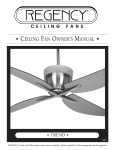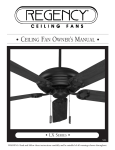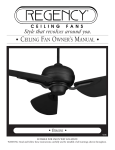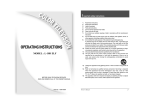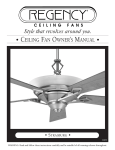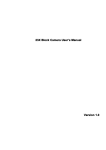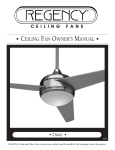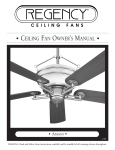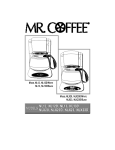Download Regency THE INDOOR/OUTDOOR FAN Owner`s manual
Transcript
• CEILING FAN OWNER’S MANUAL • 5/03 • I/O “THE INDOOR/OUTDOOR FAN” • WARNING: Read and follow these instructions carefully and be mindful of all warnings shown throughout. GENERAL INSTALLATION & OPERATION INSTRUCTIONS IMPORTANT S AFEGUARDS: 1. To ensure the success of the installation, be sure to read the instructions and review the diagrams thoroughly b e f o r e be gi n n in g. 2. To avoid possible electric shock, be sure electricity is tur ned off at the main power box before wiring. All electrical connections must be made in accordance with local codes, ordinances and/or the National Electric Code. If you are unfamiliar with the methods of installing electrical wiring and products, secure the services of a qualified and licensed electrician as well as someone who can check the strength of the supportive ceiling members and make the proper installation(s) and connections. 3. Make sure that your installation site will not allow rotating fan blades to come in contact with any object. Blades should be at least 7 feet from floor when fan is operating. 4. The fan should be mounted on a ceiling outlet box, an approved box UL listed as “suitable for fan suppor t” is required. The box and its supporting members must be able to support the moving weight of the fan (at least 35lbs.). The box must not be able to twist or work loose. Installation on a concrete ceiling should be performed by qualified personnel. 5. Blades should be attached after motor housing is hung and in place. Fan motor housing should be kept in the carton until ready to be installed to protect its finish. If you are installing more than one ceiling fan, make sure that you do not mix fan blade sets, as each blade is part of a weighted set. 6. After making electrical connections, spliced conductors should be turned upward and pushed carefully up into outlet box. The wires should be spread apart with the common conductor and the grounding conductor on one side of the outlet box, and the “HOT” wires on the other side. 7. Electrical diagrams are for reference only. 8. After fan is completely installed, check to make sure that all connections are secure to prevent fan from falling and/or causing damage or injury. 9. The fan can be made to work immediately after installation - the bearings are adequately charged with grease so that, under normal conditions, further lubrication should not be necessary for the life of the fan. 10. The fan should be turned off and allowed to stop rotating before reversing fan direction. 1 IMPORTANT SAFETY PRECAUTIONS Thank you for choosing a Regency Ceiling Fan. You have chosen the best! Your new ceiling fan has been designed to provide many years of service and enjoyment. WARNINGS: * Disconnect power by removing fuse or turning off circuit breaker before installing the fan and/or optional lighting. * To reduce the risk of fire, electric shock, or personal injury, mount to outlet box marked “acceptable for fan support” and use mounting screws provided with the outlet box. Most outlet boxes commonly used for the support of lighting fixtures are not acceptable for fan support and may need to be replaced. Consult a qualified electrician if in doubt. * To reduce the risk of fire, electrical shock, or personal injury, only use this fan with an appropriate speed control device designed for use with this ceiling fan. * To reduce the risk of personal injury, do not bend the blade arms when installing or balancing the blades or cleaning the fan. Do not insert any objects between rotating fan blades. NOTE: T he im p or t a n t p r e c a u t i o n s , s a f e g u a r d s a n d i n s t r u c t i o n s a p p e a r i n g i n t h i s m a n u a l a r e n o t m e a n t t o c o v e r a ll possible conditions and situations that may occur. It must be understood that common sense, caution, and care are factors which cannot be built into this product. These factors must be supplied by the person(s) i n s ta l l i n g , ca r in g f o r an d o p er at i n g th e u n i t . TOOLS AND MATERIALS REQUIRED • Phillips screwdriver • Blade screwdriver • Wrench or pliers • Wire cutter • Stepladder • Wiring supplies as required by electrical code 2 UNPACKING YOUR FAN 1. Unpack your fan and check the contents. Do not discard the carton. If warranty replacement or repair is ever necessary, the fan should be returned in original packing. Remove all parts and hardware. Do not lay motor housing on its side, or the decorative housing may shift, be bent or damaged. 2. Examine all parts. You should have the following: 1 6 2 4 3 5 11 9 REV LOW 7 HI MED 8 OFF 10 1. Mounting bracket 8. Blade arm to blade screws w/washers 2. Ceiling canopy 9. Downrod pin and cotter pin 3. Downrod/ball assembly 10. Remote control transmitter and receiver w/wall holster 4. Fan housing with motor and blade arms 11. Light bulb (100W “J” type) 5. Shade 6. Fan blades (5) 7. Bracket hardware (wood screws, washers, wire nuts) Recommended for uplight: Four candelabra base (E12) 40W bulbs (not included) 3 PREPARATION Parts identification on assembled fan Canopy Fan Housing Downrod Blade Blade Arm Glass Shade PREPARATION: Verify that you have all parts before beginning the installation. Check foam insert closely for missing parts. Remove motor from packing. To avoid damage to finish, assemble motor on soft padded surface or use the original foam inset in motor box. Do not lay fan on its side as this could result in shifting of motor in decorative enclosure. INSTALLING THE MOUNTING BRACKET Caution: To avoid possible electrical shock, be sure elec- tricity is turned off at the main power box before wiring. All wiring must be in accordance with National and Local Electrical Codes and the ceiling fan must be grounded as a Ceiling Fan Outlet Box precaution against possible electric shock. 1. Locate ceiling area where fan is to be mounted, being sure location agrees with the requirements in the minimum clearance section of this guide. Mounting area must be sound and of adequate size to support 35 lbs. (p. 1, #3 and #4) Hanger Bracket 2. If not already present, mount a UL listed outlet box marked “suitable for fan support” following the instructions provided with the outlet box. The outlet box must be able to support a minimum of 35 pounds. 3. Attach hanger bracket to outlet box using screws provided with the outlet box. 4 Flat Washer Spring Washer Outlet Box Screw ASSEMBLY INSTRUCTIONS: DOWNROD AND CANOPY 1. Carefully support fan housing (motor) in its styrofoam packing with the mounting collar (where the wires come out) facing upward. 2. Remove ball from downrod by loosening set screw in the side of the ball. Slide ball down and remove ball pin; remove ball. 3. Feed the wires from top of fan through the end of the downrod, and set end of downrod into mounting collar so the hole in the downrod lines up with the hole in the side of the mounting collar. 4. Insert downrod pin through holes in mounting collar and downrod and insert cotter pin to secure downrod. 5. Tighten security screw against downrod using a large flat blade screwdriver to ensure a tight fit against downrod. Tighten lock nut to mounting collar. Hook-up Wires (5) NOTE: Fan has 6 feet of hook-up wire in case you are using a long extension downrod. Wires can be cut so only 8 inches or so extend beyond the top of the downrod to make the electrical connections easier and safer. Ground Wire Ball 6. Feed wires through canopy and slide canopy over downrod to lay on top of fan. It will be attached to ceiling later. Canopy Downrod (Optional extension shown) 7. Feed wires through ball and slide ball over downrod, past hole in the top end of downrod. Insert ball pin (removed in Step 2), slide ball up and tighten set screw to secure ball in place. 8. Install 4 candelabra base bulbs (E12, 40w max) in top sockets. Mounting Collar Downrod Pin Fan Housing 5 Security Screw and Lock Nut Cotter Pin 40W Candelabra Base Bulbs INSTALLING THE FAN 1. Lift ball/downrod/fan into hanger bracket opening. NOTE: The tab opposite hanger bracket opening should fit in slot on ball. 2. Install remote control receiver (with codes set) and make wire connections, (refer to sections titled “Remote Control” and “Electrical Connections”). 3. Slide canopy up and fasten to hanger bracket with screws provided. Hanger bracket tab Ball slot Ball WARNING: To avoid damaging the blade arms and blades, do not install blades onto fan until fan is fastened to ceiling. If arms are bent or misaligned, excessive wobble may occur. 6 REMOTE CONTROL GENERAL INFORMATION Multiple code choices are included with your fan’s remote control in case: • you have more than one remote control fan and want them to respond only to their own remote control • you have other radio controlled devices in your home that may interfere with the fan remote control (i.e. garage door opener) • you experience radio interference on a chosen frequency (code setting) S ET-UP AND OPERATING INSTRUCTIONS S e t t i n g t h e c o de : This unit has 16 different code combinations. To set the code, perform these steps: 1. Setting the code on the TRANSMITTER [Fig. 1]: a. Remove battery cover. b. Slide code switches to your choice of ON or OFF position. Use a small screwdriver or ball point pen to slide each switch firmly up or down. c. Install 9v battery (not included). d. Replace battery cover on transmitter. 2. Setting the code on the RECEIVER [Fig. 2]: a. Locate the code switches on the bottom of the remote receiver. b. Slide code switches to the SAME POSITIONS as set on your transmitter. ON 1 2 3 RECEIVER Antenna TRANSMITTER 4 ON 1 PID ON ECE 2 3 4 NO 4321 1 2 3 4 Code Switches Code Switches Fig. 1 Fig. 2 After codes are set, install the receiver in the space above the ball in the hanger bracket [Fig. 3]. Be careful not to pinch any of the receiver’s wires. Hanger bracket Ball Receiver 7 Fig. 3 ELECTRICAL CONNECTIONS Four wires are connected to the fan (plus the ground wire). Black - the “hot” power to run fan. White - the “common” power to run fan and light, also referred to as “AC neutral”. Blue - the “hot” power for lower light. Gray - the “hot” power for upper light. Green - ground wire. WH SUPPLY 110v (BLACK) CK MMON (WHITE) SUPP LY CO ITE Receiver Antenna G TE E RA Y BLAC K GR HI CK O UN D N LU BLA WH BL UE ITE EE W B Six wires are connected to the remote control receiver. Four will connect to the four wires coming out of the fan (matching color to color) and the remaining black wire and white wire will connect to the building 110v AC circuit. BLA GR * Be sure electricity is turned off at the main power box before wiring.* GRA Y BE SURE ELECTRICITY IS TURNED OFF AT THE MAIN POWER BOX BEFORE WIRING. Connect six power wires as shown [Fig. 1], using wire nuts provided. Connect green ground wires to building ground wire circuit. Extend antenna wire inside canopy, but do not attach to any other wire. Fig. 1 NOTE: If power to the fan’s electrical ceiling box is controlled by a wall switch, the wall switch must remain ON for the radio remote control to operate. Turning the wall switch OFF will turn off all fan/light function and resets the receiver back to default mode. The wall switch will need to be turned back ON to allow use of remote control. * Restore power by replacing fuse or resetting circuit breaker ONLY AFTER ALL INSTALLATION AND ELECTRICAL WORK IS COMPLETED AND DOUBLE-CHECKED. BLADE ATTACHMENT 1. Place washer on screw. Insert this assembly through the blade and start the screw into the blade arm. Repeat this procedure without tightening the screw until all 3 screws have been started into the blade arm (Fig. 2). Screw Washer 2. Tighten each screw, starting with center screw. Blade Blade Arm 8 Fig. 2 COMPLETING THE INSTALLATION 1. Install “J” type halogen bulb into lower socket on bottom of fan. Do not touch bulb with bare fingers. Use tissue of bulb’s packing to keep fingerprints and oils off bulb’s surface. 2. Lift bottom glass shade up to fan, aligning indentations in glass with nubs on bottom of fan [Fig. 2]. Turn glass shade to secure in place. Do not overtighten or glass may break.. Fan body Nub Nub Lower socket 100W "J" type halogen bulb Glass shade Indentation CONGRATULATIONS! Your fan is now ready to enjoy! 9 OPERATION OPERATING BUTTONS ON THE TRANSMITTER H I – f a n h ig h s p e e d M E D – f a n m e d iu m s p e e d LO W – fa n lo w s p ee d O FF – fan s peed of f U / L – l i g h t b r i g h t n e s s a n d o f f f u n c t i o n fo r u p l i g h t D / L – l i g h t b r i g h t n e s s a n d o f f f u n c t i o n f o r l ow e r li g h t RE V – r e v e r s e ( d o w n o r u p ) a i r f l o w • The light functions are controlled by pressing the light buttons. Hold a button down to increase or decrease light brightness. Tap button quickly to turn light off or on. The U/L button controls the up-light and the D/L button controls the lower light. They can be controlled independently and each has its own memory circuit that will keep the preset brightness you have chosen. Just release the button at the desired light brightness and that setting will be remembered the next time the light is turned on. The pre-set brightness can be changed by holding down the light button again until the new desired brightness is reached. • Keep pressing the button for more than one second to dim the light and vary it cyclically from dim to bright and back again. • Range of the transmitter is approximately 25 ft. • Forward/Reverse Direction: Forward is a counterclockwise rotation of the blades when viewed from beneath the fan. This will create a downward breeze that can be felt below the fan. This is the normal direction for the fan to run when the weather is warm. Reverse (clockwise) will draw air up through the blades and towards the ceiling, down the walls, and into the living space during the cooler months. WARM MONTHS For war d (counterclockwise) C OO L M O NT H S Rever se (clock wise) 10 CARE AND CLEANING Periodic cleaning of your new ceiling fan is about the only maintenance that is needed. Only use a soft brush or lint free cloth to avoid scratching the finish. DO NOT use water when cleaning your ceiling fan. It could damage the motor or the blades and/or create the possibility of electrical shock. Periodically it may be necessary to re-tighten blade to blade arm screws or blade arm to motor screws to prevent clicking or humming sound during operation. This is especially true in climates with broad temperature and humidity ranges and in fans with painted or high gloss blades. When dusting the blades, you must support the blade to prevent its bending - no pressure should be applied to the blades. If you experience any flaws in the operation of your fan, please check the following points: TROUBLESHOOTING - IN CASE OF DIFFICULTY C A U T I O N : S w i t c h o f f p o w e r s u p p l y b e f o r e car r y in g o u t a n y of t h e s e ch e ck s . I f f a n w i l l n o t s t a r t: • Check main and branch circuit breakers and/or fuses. • Check line wire connections to fan and switch housing wiring. • Make sure a fresh battery is in the remote control transmitter. • Make sure the codes on both the transmitter and receiver are set the same. • Fully extend the receiver antenna inside of canopy. I f fa n is n oisy : • Check that all screws in motor housing are snug (but not overtight). • Check that the screws securing blades to the motor are tight. • Check that wire connectors in the canopy are not rattling against each other or the interior wall of the canopy. • Check that all glassware is finger tight and that bulb(s) are well held in the sockets. • Check that the canopy is firmly attached to hanging bracket and not vibrating against ceiling. If f an wob bles : • Check that all blades are firmly screwed into blade arms. • Check to make sure that all glassware and shades are fastened properly. • Wobble can also result from even the smallest deviations in distance from blade tip to blade tip - if measurements from blade tip to blade tip are not equal, loosen screws connecting blade to bracket one at a time and adjust blade(s) so that distances are equal. Interchanging adjacent blades may redistribute mass and result in smoother operation. • Check to make sure that all hanger bracket screws and electrical box fasteners are tight. If electrical box is not tight to the building, the whole fan, bracket, and electrical box may be moving as a result of the wobble. This can be dangerous if the electrical box should work loose from the building. Visit www.regencyfan.com 11 THANK YOU FOR PURCHASING A REGENCY CEILING FAN. Write to us at: Regency Ceiling Fans P.O. Box 730 Fenton, MO 63026 Visit us on the Web at: www.regencyfan.com 5/03 Regency Ceiling Fans
















